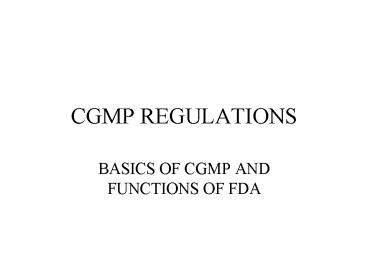CGMP REGULATIONS - PowerPoint PPT Presentation
1 / 18
Title:
CGMP REGULATIONS
Description:
CGMP REGULATIONS BASICS OF CGMP AND FUNCTIONS OF FDA CGMP TRAINING This program has been designed to encourage your active participation Your participation will make ... – PowerPoint PPT presentation
Number of Views:907
Avg rating:5.0/5.0
Title: CGMP REGULATIONS
1
CGMP REGULATIONS
- BASICS OF CGMP AND FUNCTIONS OF FDA
2
CGMP TRAINING
- This program has been designed to encourage your
active participation - Your participation will make learning more
interesting.
3
HOW TRAINING WORKS
- We will give you inputs.
- Listen and follow pictorials in your workbook
- When told, write in information or complete a
progress check.
4
HOW TRAINING WORKS
- Progress checks make sure that you fully
understand what you have heard. - No one grades your progress checks.
- Writing the correct answers will help you learn
and remember.
Idea
5
GMP ORIENTATION
- Introduction
- Quality Management
- Terminology
- Premises
- Equipment
- Personnel
- Sanitation Hygiene
- Material Testing
6
Introduction
- Purpose of GMP
- Good Manufacturing Practice (GMP) regulations
were introduced as a means to ensure that a given
product is processed reliably, repeatedly,
consistently, safely and to a high quality. - In the pharmaceutical processing industry GMP
is an essential part of the production process.
7
Introduction
- Why GMP is established?
- Just prior to start of the 2nd World War there
was a serious poisoning incident in the USA. This
prompted the introduction of the Food, Drugs and
Cosmetics Act 1938, by US Food and Drugs
Administration (FDA). The intention of the new
act was to ensure that food, drugs, cosmetics and
biological products were safe for human contact. - Hence the need to establish Good Manufacturing
Practice (GMP).
8
Introduction
- The Indian Government made Current Good
Manufacturing Practice (Schedule M) part of
Drug Cosmetic Act in 1940
9
Manufacturing Guidelines
Current Good Manufacturing Practice
Regulations
cGMPs
FDA
Entrepreneur
10
Why cGMP Training
Why is it necessary to Participate
in this cGMP Training Program
When We All Follow the SOPs?
When we carefully follow each step of our SOPs
we are also complying with the cGMP regulations!
11
cGMP training must be reinforced by on-the-job
supervision
Now thats a Reinforcement
Follow the SOPs
and where required supplemented by a review
training course.
12
I follow SOPs Sir
Thats Good. Be an example to others.
13
DOCUMENTATION
- Specifications describe in details the
requirements with which the products or
materials used or obtain during the
manufacture have to conform. They serve as a
basis for quality evaluation - Manufacturing formulae, Processing and
packing instructions state all the starting
materials used and lay down all processing and
packaging operations - Procedures give directions for performing
certain operations e.g. cleaning, clothing,
environmental control, sampling, testing,
equipment operation.
14
Validation
DQ, IQ, OQ and PQ
- Design user or process requirements
- Install installation qualification
- Operate operational qualification
- Validate performance qualification and
process validation - Review periodically ( change control)
15
This V-Model figure shows how links the URS,
Functional Specification, Design Qualification
and the Testing Qualifications (IQ, OQ, PQ)
User Requirement Specification
Performance Qualification
Functional Specification
Operational Qualification
Design Qualification
Installation Qualification
Installation
Flow chart
16
Water system design (2) 1. Ball valves are
unacceptable
2. Bacteria can grow when the valve is closed
3. The water is contaminated as it passes through
the valve
Stagnant water inside valve
17
TQM
- TQM incorporates the concepts of
- product quality
- process control
- quality assurance and
- quality improvement
- It is the control of all transformation processes
of an organization to better satisfy customer
needs in the most economical way. - Total quality management is based on internal or
self-control, which is embedded in each unit of
the work system (technology and people). Pushing
problem solving and decision-making down in the
organization allows people who do the work to
both measure and take corrective action in order
to deliver a product or service that meets the
needs of their customer.
18
SQC SPC
- Statistical Process Control (SPC) is a method of
monitoring, controlling and, ideally, improving a
process through statistical analysis. - Its four basic steps include
- measuring the process,
- eliminating variances in the process to make it
consistent, - monitoring the process, and
- improving the process to its best target value.































